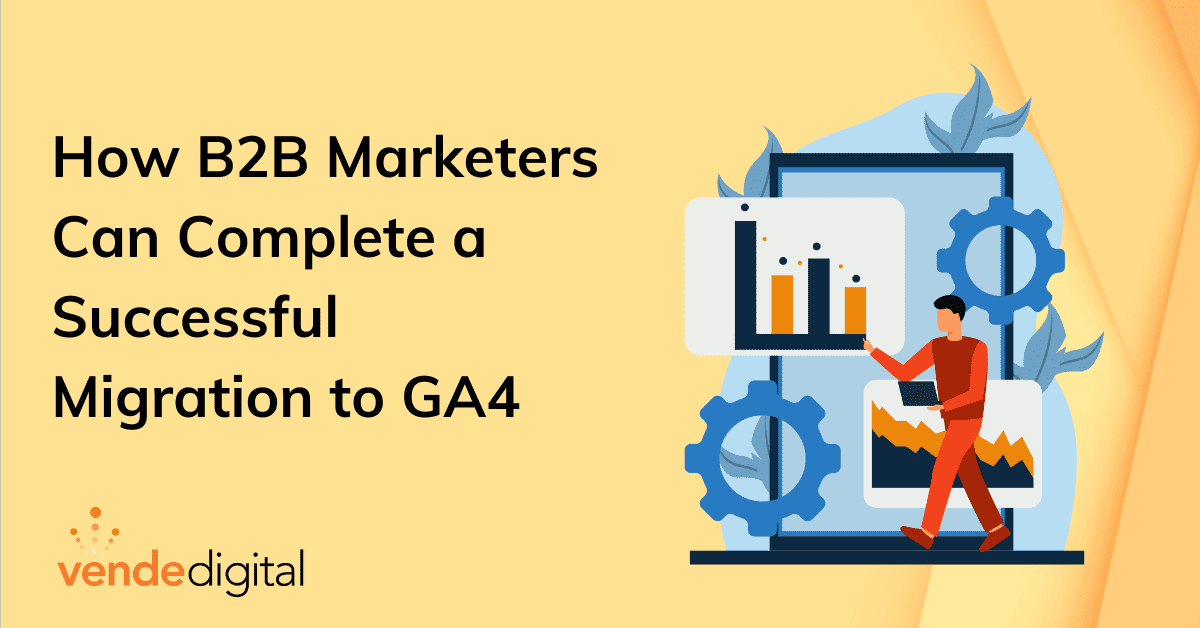
GA4 Migration: What B2B Marketers Need to Know
In this blog post, we’ll explore the key differences between Google Analytics 4 (GA4) and Universal Analytics (UA) and provide actionable steps for B2B marketers to prepare for a smooth GA4 migration.
GA4 offers several new features and improvements over UA that can help B2B marketers optimize their marketing campaigns. By familiarizing yourself with GA4 and its new features and taking steps to prepare for the switchover, you can ensure a smooth transition and continue driving your business forward.
Watch: Paul Slack and I walked through all aspects of GA4, including its features, benefits, implementation, analytics capabilities, and prospects in a recent Demand Gen Jam Session. Check it out here.
The Evolution from UA to GA4
GA4 is a significant upgrade from UA, offering B2B marketers a more comprehensive understanding of customer behavior across multiple devices and platforms. Unlike UA, which primarily focuses on sessions and pageviews, GA4 introduces a new data model centered around events and parameters.
GA4 Offers More Flexibility and Deeper Insights
UA was designed as an easy-to-use analysis and reporting tool. It relied on a simple structure and offered over 150 predefined reports. GA4 provides more flexibility and emphasizes event-based tracking over session-based tracking, making deeper analysis and machine learning easier. However, more flexibility often results in more complexity.
GA4 may seem more complicated at first, but the sift to event-based tracking enables greater flexibility in tracking and analysis, empowering marketers to delve deeper into user interactions and engagement. GA4 also provides a more holistic view of customer behavior, encompassing various touchpoints and devices. The new data model in GA4 focuses on events and parameters, allowing for enhanced tracking and analysis.
Other notable differences
- Views in UA have been replaced with Data Streams in GA4, combining data from multiple sources for more comprehensive tracking, including cross-domain and cross-device tracking.
- GA4 introduces Engaged Sessions as a replacement for traditional behavior metrics like pages per session, average session duration, and bounce rates. Engaged Sessions are sessions lasting longer than 10 seconds or involving a conversion. Engaged Sessions per User indicates user engagement by dividing the number of engaged sessions by the number of users, offering insights into user interaction.
Benefits of GA4 for B2B Marketers
GA4 brings several advantages for B2B marketers, empowering them with enhanced insights and advanced analytics capabilities. Some of the key benefits include:
Cross-Device Tracking - Much better than UA, GA4's cross-device tracking enables a more comprehensive understanding of user journeys. B2B marketers can learn how prospects and customers interact with their brand across different devices, helping optimize marketing strategies and personalize user experiences.
Enhanced User Engagement Tracking - With GA4, B2B marketers can track user engagement beyond pageviews. Events and parameters allow for granular tracking of user actions on a website or app. This data enables deeper analysis of user behavior and helps identify high-value interactions.
Advanced Reporting and Analysis - GA4 introduces the Analysis Hub, a powerful feature that provides built-in reports and custom analysis capabilities. B2B marketers can leverage this tool to explore data, gain valuable insights, and discover trends in user behavior. The Exploration report allows for flexible data exploration, enabling the comparison of multiple dimensions and metrics.
Looking Ahead and Best Practices
The future of GA4 holds exciting possibilities for B2B marketers. As the industry continues to evolve, there are a few key considerations to keep in mind:
UA Sunset Timeline - UA will cease to function starting from July 1st. While it is not possible to directly transfer data from UA to GA4, Google will retain UA data until December 31, 2023. However, it is crucial to take action to preserve your data before Google deletes it. You have a couple of options:
- Save your data by exporting it into a CSV file, ensuring you have a backup copy.
- Export your data to a data warehouse like BigQuery, which provides a more comprehensive and scalable data storage and analysis solution.
Utilizing a Dashboard - It’s essential to recognize that our websites are not the only place we engage with users. Like UA, GA4 can only show us what’s happing on our website. By leveraging a third-party dashboard software, you can integrate data from multiple sources to gain a comprehensive view of your metrics, unlock deeper insights, and enhance reporting and analysis capabilities beyond what GA4 alone can provide.
Integration of First-Party and Third-Party Data - GA4 aims to provide a more comprehensive view of customer behavior by integrating first-party and third-party data sources. B2B marketers should explore ways to combine data from various platforms and sources to gain deeper insights into their audience and improve targeting.
Privacy Regulations and Data Governance - Data protection and user consent are paramount as privacy regulations become more stringent. B2B marketers must ensure compliance with privacy regulations while using GA4. Familiarize yourself with the features and settings in GA4 that prioritize user privacy, such as data deletion controls and consent management tools.
Continuous Learning and Upgrading - Google is actively investing in GA4, and the platform will continue to evolve. Stay updated with new features, enhancements, and best practices through official documentation, blogs, and industry forums. Continuous learning and adapting to new trends will help B2B marketers maximize the potential of GA4.
Embrace the Future Because It’s Coming Whether You Like It or Not
GA4 isn’t a bad thing. It’s just different. The GA4 migration presents B2B marketers with an opportunity to gain deeper insights into customer behavior and unlock advanced analytics capabilities. By understanding the differences between GA4 and UA and following the recommended steps, marketers can ensure a seamless transition and leverage the full potential of GA4 for their B2B marketing efforts.
Remember, GA4 is a technical upgrade and a strategic shift that empowers B2B marketers to make data-driven decisions and deliver exceptional user experiences. Embrace the change, adapt your strategies, and embark on a journey of enhanced analytics with GA4.
Common Questions B2B Marketers Have About GA4
Q: What is the main difference between Google Analytics 4 (GA4) and Universal Analytics (UA)?
A: GA4 introduces a new data model, focusing on event-based tracking, providing comprehensive insights across devices/platforms, while UA relies on session-based tracking.
Q: How can B2B marketers prepare for the GA4 migration?
A: Understand key differences, assess tracking setup, plan GA4 implementation, instrument the website/app, and utilize data streams for accurate data collection.
Q: What are the benefits of migrating to GA4 for B2B marketers?
A: Improved cross-platform tracking, enhanced user journey analysis, machine learning capabilities, and deeper integration with Google's advertising/marketing products.
Q: Can B2B marketers continue using Universal Analytics alongside GA4?
A: Yes and No. After July 1, 2023, Universal Analytics will no longer track data. However, you can access historical data through the end of 2023. Starting in 2024, all of your data will be removed from Google.
Q: How can B2B marketers leverage GA4 to improve marketing strategies?
A: Gain insights into user behavior, optimize campaigns with event data, analyze customer lifetime value, and implement enhanced audience segmentation. Utilize machine learning for effective strategies.
Preparing for the Transition to GA4
Transitioning from UA to GA4 requires careful planning and execution. We have compiled the following 12 steps to help you transition to GA4 and optimize your marketing efforts.
- Set clear goals and KPIs that align with your business objectives to track and measure marketing success effectively.
- Map existing tracking features to ensure continuity and consistency in tracking. Identify the events and parameters you need to track in GA4 and replicate the tracking setup accordingly.
- Review your website's tags and triggers to ensure they are compatible with GA4. Update any event-based triggers to align with GA4's event-driven model. Be mindful of any custom dimensions or metrics that require migration, as they might have different naming conventions in GA4.
- Familiarize yourself with event-based tracking and implement it properly to capture relevant user interactions and actions.
- Define custom events and parameters tailored to your B2B marketing strategy, such as form submissions or content downloads.
- Use GA4's enhanced measurement features like user engagement tracking, funnel analysis, and predictive metrics for deeper insights.
- Set up multiple data streams and use data filters to track information from various sources and ensure accurate analytics.
- Leverage GA4's machine learning capabilities for data-driven decision-making, including automated insights and predictive analytics.
- Preserve existing UA data to ensure you don’t lose critical historical data and end up with gaps.
- Educate your team about GA4's features, functionalities, and reporting capabilities through documentation, training, and seeking expert support.
- Thoroughly test and validate your tracking implementation, ensuring accurate tracking of events, parameters, and conversions.
- Monitor and optimize performance by analyzing data, reviewing KPIs, reports, and dashboards, and making data-backed optimizations to enhance marketing strategies.
Key GA4 Migration Takeaways:
- Creating a new GA4 property and installing the tracking code are the initial steps in the transition process.
- Mapping existing tracking features and updating tags and triggers ensures data continuity between UA and GA4.
- GA4's cross-device tracking and enhanced user engagement tracking offer valuable insights for B2B marketers.
- The Analysis Hub provides advanced reporting and analysis capabilities, empowering marketers to make data-driven decisions.
- Integrating data sources and complying with privacy regulations are key considerations for B2B marketers using GA4.
- Staying informed and continuously learning about GA4 updates and best practices is crucial for maximizing its potential.
How Can We Help?
Get ahead of the game and ensure you're getting the most out of GA4 by signing up for an Analytics Consultation. Our expert team will provide a comprehensive audit of your GA4 instance, migrate your goals and events, and enhance tracking for improved performance and insights. Our advanced visualization capabilities allow you to analyze GA4 data alongside other channel activities.







